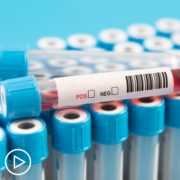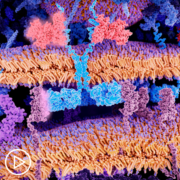Related Programs:
Transcript:
Katherine Banwell:
Hello and welcome. I’m your host, Katherine Banwell. Today’s program is a continuation of our Thrive Series and we’re going to discuss coping with MPN symptoms and managing treatment side effects. Before we get into the discussion, please remember that this program is not a substitute for seeking medical advice. Please refer to your healthcare team about what might be best for you.
Let’s meet our guest today. Joining me is Dr. Naveen Pemmaraju. Dr. Pemmaraju, welcome. Would you please introduce yourself?
Dr. Pemmaraju:
Oh, thank you, Katherine and team. Just an honor to be here.
I’m Naveen Pemmaraju, a professor of leukemia at MD Anderson Cancer Center in Houston. And I also serve as one of our executive directors for the MD Anderson Cancer Network, and I specialize in MPNs and rare leukemia. So, happy to join you once again, Katherine.
Katherine Banwell:
Thank you so much for being with us today, taking time out of your schedule. Well, Dr. Pemmaraju, when it comes to living and thriving within an MPN, managing disease symptoms and treatment side effects is a big part of that. How can symptoms and side effects impact life with an MPN?
Dr. Pemmaraju:
Katherine, I’m glad you asked about that because I think before we get into the science and the pathobiology and all these complex things, it really starts with the patient. And as you and your team and others have really noted, the MPN for many of our patients, it is a chronic, often lifelong journey. And we really need to reemphasize in this modern era, the patient-centered experience and the caregiver experience.
And so I would emphasize a few things. One is that our MPNs are oftentimes so-called invisible diseases to other people. So, this phrase that just really is tough for us to hear for our patients and our loved ones, oh, you don’t look that you’re sick. You don’t look like you have cancer. So, it emphasizes the internal part of the internal medicine, that’s one. Number two, it reminds you that you cannot tell on the external what kind of a war, a cytokine war that is going on inside of a patient. And so even though the blood counts are normal, the spleen is okay, the treatment paradigm is going okay, we don’t know what’s really going on. So, that’s why our great friend and colleague Ruben Mesa invented and pioneered the MPN symptom burden to really nail down what’s going on.
And then third is our treatments, Katherine, our treatments, while overall halting or stopping or helping the MPN can then introduce a whole other round of toxicity, side effects, and so we need to manage that.
So, both the disease itself and the treatments, two separate entities, and that’s what we need to be monitoring in the clinic.
Katherine Banwell:
All right, well, thank you for that. As we get into the discussion, Dr. Pemmaraju, it’s important to note that some of the issues we’ll be talking about today are symptoms of the MPN, and others may be treatment-related side effects. So, let’s start with side effects. What are the most common issues associated with the main MPN treatment classes? Let’s start with JAK inhibitors.
Dr. Pemmaraju:
Oh, very nice. Yeah, that’s exactly the way I think about it too. So, with our JAK inhibitors, we now have 10 years since the approval of the ruxolitinib, the first in class. And now we have two more approved agents which are known as fedratinib (Inrebic) and pacritinib (Vonjo), and hopefully a fourth agent, momelotinib, which is under regulatory review at this time.
[Editor’s Note: Momelotinib (Ojjaara) was approved by the U.S. Food and Drug Administration (FDA) on Sept 15, 2023 for the treatment of intermediate- or high-risk myelofibrosis, in adults with anemia.]
So, we have a whole class of drugs. They have some similarities and then some differences, but in general, the JAK inhibitor class are well-tolerated drugs, but each of them has some side effects.
I’d like to go through them just as a top-line overview. It’s very important. Number one for the ruxolitinib agent, the one that’s been around longest. This one is usually well-tolerated as we said, but you do have to look out for a few things. Non-melanoma skin cancers can be increased in some of our patients, so the importance of dermatology and skin evaluations. Some infections such as viral herpes, zoster, and shingles, so we need to be aware of that. And then weight gain, weight gain is something that we’re seeing more over time as we appreciate the drug, particularly as we move it into earlier lines of therapy, such as p.- vera.
As I look at the other agents, the fedratinib already carries an FDA black box warning for an encephalopathy syndrome, thought to be Wernicke’s encephalopathy, which can affect the brain. But really an encephalopathy syndrome, which means we have to check thiamine levels and replace them and be aware of that. That’s vitamin B1 and also GI side effects with that agent. And then finally, the pacritinib agent has a few toxicity and side effects.
Again, all these are on the package label insert, well-known. Some GI side effects, particularly in the first few months, including diarrhea, and we need to watch out for bleeding and these kinds of effects, especially in the opening days and weeks of the agent. So, again, JAK inhibitors, well-tolerated class, oral medicines, but can have some notable side effects that we have to follow together in the clinic.
Katherine Banwell:
What about interferon? What are some common side effects?
Dr. Pemmaraju:
Yeah, great. So, the interferon class, which actually now is a class of drugs. We started out as let’s call it the regular Interferon, which was multiple times a week dosing. Then the Pegylated Interferon, which went down to once a week. And then now we have the ropeginterferon (Besremi), which is the recently approved agent in p. vera, which is every two weeks spaced out to every month.
So, as you said, in this class of drugs, what’s old is new again. These drugs have actually been around longer than the JAK inhibitors, interestingly. You do have to be mindful. These are a very serious set of drugs. We usually set aside a good amount of time to talk about the side effects, and they are many historically.
The main ones include psychiatric neurological side effects. So, it can cause a depressed mood, change in the mood, even depression. Hugely important, so everyone needs to be aware of that, including the caregivers. It can cause autoimmune side effects, so such as thyroid, liver, these type of side effects. And then finally, of course, any of these Interferons can cause a flu-like profile, you know, not feeling well, particularly in the beginning days.
So, we usually try to mitigate it with lots of education to the patient, the caregiver, remind all members of the team. If you can, maybe even start at a low dose and escalate up, which is what we’re trying to do in the clinic. And then really close monitoring for stuff that you can monitor, the thyroid, the liver, the mental side effects, as we said. Usually most of our patients over time, most of them do get used to the drug. So, there is some kind of an immune component to it, but you can have side effects at any time.
I would say also, Katherine, that these later forms of the Interferon continue to improve. And so we’re seeing either less and less side effects or at least better managed, better tolerated, more understanding of these. So, a great class of drugs. And I should also say that our colleagues around the world are starting to combine the two classes of drugs for patients with myelofibrosis. And so we need to be paying attention to those combinatorial approaches.
Katherine Banwell:
What about hydrea?
Dr. Pemmaraju:
Yeah, right. Yeah, so hydroxyurea, we also have to mention that.
One of the workhorse medicines of our field. We use it in all the MPNs.
Again, an older class of drugs such as the Interferons that have been around prior to the JAK inhibitors. Used in a variety of diseases, both benign and malignant, used in sickle cell anemia. Historically has been used in both blood and solid tumor cancers, but we use it very commonly in MPNs. Almost all of our viewers are familiar. Hydroxyurea is not a benign drug. It is a chemotherapeutic agent. You know, you have to handle it with care.
And so it’s got a few side effects. It can cause some fatigue in some patients. One of the more notable classical side effects is an ulcer formation, either in the mouth area or in the lower extremities, such is in the feet, so, you know, grossly visible. It can cause some fever and not feeling well in some patients. I will say again, a lot of these drugs are generally well tolerated. Most of our patients are 60, 70, 80, and older, but you can certainly have those side effects. A lot of these drugs, Katherine, can affect the skin.
I did mention that earlier. So, ruxolitinib, even the interferons, hydrea, they can all cause skin lesions, maybe some of them associated with non-melanoma skin cancer, such as squamous cell and basal cell. So, one amazing part of the practice has been close association with our dermatology colleagues, not something I would have expected 10, 15 years ago. And that’s been a helpful part of the practice.
So, I think it’s a point where I can emphasize that, in addition to having us as the MPN or blood cancer team, Katherine, the pandemic has reminded us the importance of primary care team as well. So, it’s really two teams, someone checking the cholesterol, cancer screenings, skin checkups, mammogram, PSAs. And then in coordination with your MPN team and then everyone working together, so colonoscopies, et cetera. So, just a plug there, especially the last three, four years where people have gotten behind to make sure that we’re keeping up with that part of the deal as well.
Katherine Banwell:
With all the testing, yeah.
Dr. Pemmaraju:
Exactly, right.
Katherine Banwell:
You mentioned a couple of treatment side effects and how they’re managed, but in general, across the board, are treatment side effects managed in the same way, in similar ways?
Dr. Pemmaraju:
Now, that’s a great question. So, here I’ve given you this nice list, kind of academic version of the list, but boy, no, right. And all my patients and everyone out there knows that there’s some varied practices. You know, the varied practices are not only, as you say, across the country and across the world, but also even in our own clinics, patient to patient. The MPNs have humbled and taught us that one person’s MPN can be starkly different from the next, so on and so forth.
So, I’m not just talking about the difference between PV, ET, myelofibrosis, and systemic mastocytosis. I’m talking about one person’s MF is completely different than the other. I think there are a couple of things I didn’t mention. So, pruritus, or itching is one of the great symptoms really. It’s not a side effect usually, but it’s a symptom of the MPN. There are some ways to treat that in the clinic.
Fatigue really has no great way to treat it. Usually when you introduce one of the JAK inhibitors that can improve. On the side effects side, as we were mentioning, a lot of these are unsatisfying things. The flu-like symptoms of the interferon, the weight gain of the JAK inhibitor. So, I think what you’re saying is so correct, and let me admit it, I’m going to be the first to admit it, there’s not really a good standard playbook.
But on the other hand, I think personalization. As we’ve always said, in our rare disease space, if you have a disease, it’s not rare to you. It’s what you have, it’s what your spouse is dealing with, your loved one, your mother with you. And so, I would advocate here that there’s a personalized playbook there. I would say that there are three guiding principles though. One is when you have side effects of a medicine, the first thing to do is let your healthcare provider team know. I know that sounds obvious, but here I am in the clinic and sometimes we don’t find out until later.
And so some of that is because the patient says to themselves, let’s tough it out. Or they may not know, or they may not be able to, or it may not be easy to communicate with our healthcare teams. Two is when you’re evaluating, every patient’s case is different. This is not specific advice, as you said, at the top of the hour here. But in a general sense, you really need to evaluate if the side effect is peculiar or particular to just that patient case, so idiosyncratic, unpredictable, notable.
Or, is it a general expected sort of something that you thought could already happen and then go with it from there? And then finally, the concept of dose interruptions, dose reductions, treatment holidays, something very important. So, basically a lot of different ways you can go, but no standard or uniform playbook in our MPN field, as you and the team well knows.
Katherine Banwell:
Thank you for that Dr. Pemmaraju. I’d like to move on to common MPN symptoms now. Let’s start with myelofibrosis. What are the symptoms associated with this particular MPN?
Dr. Pemmaraju:
Excellent question. So, for the myelofibrosis, generally thought to be our most advanced of the MPNs, can be low risk, intermediate to high risk. We’ll focus our comments here on intermediate to high risk, the more advanced MF. This is important because not only what I’m going to tell you is sort of a subjective list of symptoms, but because of the work of my great friend, Ruben Mesa, who pioneered the MPN symptom burden, we’ve actually been able to, as he and I say, quantify the unquantifiable.
So, take subjective information and turn it into objective. For example, we know that among the three MPNs, PV, ET, and MF, that fatigue is by far the most common symptom that our patients report. It’s a fatigue that’s more than the general feeling tired at the end of the day. It’s sometimes a wiped-out fatigue. Some of our patients will have pruritus or itching. Many of our patients will have early satiety, which means getting full too early because either the spleen is too big, decreasing the appetite. Bone pain and neuropathy can happen in our MF patients. Brain fog and decreased concentration, huge issue among a lot of our patients.
And finally, because of the low blood counts, if a myelofibrosis patient is anemic, they can have those issues. So, fatigue, shortness of breath, even chest pain and palpitations. If the platelets are too low, or too high for that matter, bleeding or clotting.
So, the problem with myelofibrosis, it ranges the gamut from the low-risk patients, who can be treated maybe even as a PV or ET observation or not as advanced treatment paradigm, all the way to intermediate high risk where patients are cachectic, losing weight, not feeling well, drenching night sweats. And all of these can be captured on not only the scoring systems but also the symptom burden scales. And to be honest with you, this is the majority of what our patients are feeling outside of the blood counts and outside of the objective information. So much so to the point, Katherine, where a patient can present with these symptoms solely, without ever having a blood count or a bone marrow or anything, and then it leads to the work of it.
Katherine Banwell:
Oh, wow. Wow, fascinating. What about symptoms for polycythemia vera?
Dr. Pemmaraju:
Yeah, so this is a great theme that you’ve got going here, which is know your body. If you know your body, then you’re able to tell what’s abnormal or normal. p. vera can be a bit more subtle.
Oftentimes patients with p. vera can have a normal life expectancy and the longer term series in Europe show that it’s basically about the same life expectancy as the general population or slightly lower. But that doesn’t tell the whole story. Patients with p. vera can have an unbelievable symptom burden, either from the hyperviscosity of the hematocrit, the blood level being too high or the cytokine storm, that I mentioned, that makes people feel not well. So fatigue, brain fog, feelings of sluggishness, feeling too full, those are common in p. vera.
The treatments are aimed at trying to make that better. So, phlebotomy to bring the hematocrit down below 45 can make you feel a little bit lighter, a little bit better, decrease the brain fog. If you’re using either the standard treatments of hydrea or Interferon, and then, of course, the baby aspirin to prevent clots, heart attacks, stroke. The newer agents in p. vera include the ropeginterferon that we mentioned earlier, clinical trials, such as the PTG-300 that I’m a part of, that try to really keep the blood levels normal all the time.
And so hopefully help to improve the quality of life, decrease the chance of having a clot, and also hopefully try to make patients feel better from these aspects.
Katherine Banwell:
What about essential thrombocythemia or ET?
Dr. Pemmaraju:
ET, again, just like PV, you can have a lot of patients who are either incidentally diagnosed or not too much of a symptom burden. But again, here, the blood counts don’t tell the story. You can have “low risk ET” which is defined as less than 60 or no prior blood clots. So, you can be 43 years old, diagnosed with ET, your blood counts aren’t that high, but yet you’re still feeling overwhelming fatigue, itching. You’re seeing flashing things in your eyes called scotomas. You’re having small nerve or vascular issues called erythromelalgias. It’s a very elusive and difficult disease, particularly for our young patients. So, in ET, again, the same set of symptoms can happen. This fatigue, itching, the brain fog, concentration, bleeding, and or clotting.
And so again, the goal of therapy is to mitigate those. If you’re young, a lot of patients are either observed or baby aspirin. If you’re older than 60 or have high risk features, then again, cytoreductive therapy. The other aspect I should mention is you can start out with one of these and it transforms into the other. That’s called clinical or phenotypic shifts. You can start out as an ET, go to PV. You can start out as PV and go to myelofibrosis. You can start out as myelofibrosis and go to acute myeloid leukemia. So, that’s why follow-up, even over years, decades, is important, preferably with an expert team, because you never know when one of these things wants to transform. And then your side effect, or I should say your symptom profile therefore changes with that transformation.
Katherine Banwell:
Well, it’s obvious that there’s some symptom overlap along with this.
Dr. Pemmaraju:
Right.
Katherine Banwell:
And so I’m wondering what the strategies are for managing these. Let’s start with fatigue first.
Dr. Pemmaraju:
Let’s do that.
Katherine Banwell:
How do you manage that?
Dr. Pemmaraju:
This is one of the tougher parts of what we do. I’m glad you’re pinning me down to say it because really this is the majority of what we need to be talking about in the clinic. I’m going to just be honest, you know, with all the scientific breakthroughs and everything, some of these are limited. The fatigue, this is some of the strategies I use and some of the experts in the field. I think one is managing the underlying disease. So, as you mentioned, if you have high-risk, intermediate to high-risk myelofibrosis, one of the great findings of our field is the JAK inhibitor class generally helps to improve symptom burden.
So, that is the splenomegaly, the fatigue, the pruritus. Maybe not so much the itching, but some of these other things. So, I think treating the underlying disease, that’s okay. Number two is many clinics, Onc centers around the country are starting to open up a supportive care or fatigue center clinic. So, I am referring several of my patients there, we’re talking about diet, nutrition, exercise. We used to never talk about these things. Ruben Mesa has found that doing yoga and meditation can genuinely actually help the pathobiology to reduce the cytokine storm and improve the fatigue and quality of life.
Dr. Angela Fleischman, our colleague at UC Irvine, has done work suggesting that possibly an antioxidant diet such as the Mediterranean diet can help the overall general fatigue, well-being, wellness. And then of course I mentioned earlier, but I’ll mention here too, sometimes fatigue is outside of the MPN. Have you had your TSH or thyroid checked? What about your vitamin D levels? How are you doing on these PCP general checks? Things that may be contributing to the life and the happiness.
And finally, let me make a plug for mental health. I don’t know how much we were emphasizing before the COVID pandemic, but after, the last three or four years have been tough. Healthcare providers, caregivers, patients themselves, mental health checkup, that can also be contributing to fatigue, not getting out of bed, in addition to the organic medical problems. So, let me advocate a multifactorial approach, scientifically summed up as treating what you can with the underlying MPN, fine, treating the side effects and symptoms of the MPN, as you said.
And then, other, which can be a huge bucket, particularly as we get older, to not forget about that. Again, checking the thyroid level. And then when you’re on these different treatments, you can personalize it. Interferon, obviously, has its own separate set of side effects and then of course the other agents. So, I think that may be the best way to approach it. Maybe a three-bucket approach. The MPN itself, and then the treatment itself, and then the other, something like that.
Katherine Banwell:
Yeah, yeah. And as you’ve mentioned, it’s all going to be personalized and individualized, because what’s going to work for one person is not necessarily going to work for another.
Dr. Pemmaraju:
Hear, hear, well said to that. You know, you think you make a great diagnosis in the clinic, someone’s having fatigue, they’re on therapy for your MPN. You check the TSH, it’s wildly abnormal. Okay, you refer them to endocrine. Six months later, the thyroid level is completely normal now on thyroid medicine. And yet, the fatigue, brain fog, everything is still not clear.
The MPN is under good control. What gives? That’s the difficult part of these diseases. So, I really love what you said about the personalization and to keep looking and keep trying.
Katherine Banwell:
What might an increase in symptoms mean? Does it mean that the disease is progressing or that maybe it’s time to change therapies?
Dr. Pemmaraju:
Yeah, possibly. So, with all this objective evidence, there’s different buckets of disease progression. And some of them are objective and obvious, rising spleen, increasing blasts, or leukemia cells in the peripheral blood. The start of transfusion dependency for either anemia or platelets that weren’t there before. Sometimes, there are obvious things that you can point to, but there are a couple of scenarios where it’s not as obvious. You just named one. One is increasing symptom burden profile. You see, sometimes you have to think about, is it the sequela of the treatment itself or is it disease progression?
I’ll give an example. If you start on an Interferon product and the dose is too high, you may be feeling not so great from the Interferon. But maybe in that case, a simple dose reduction was the answer because then you’re still getting the anti-disease activity, less side effects and all that. So, I’ll answer your question by saying possibly, but it can’t be the whole story. So, increasing symptoms is a harbinger, it’s a red flag. In the clinic, it means pause. Workup, is this a subject of the treatment itself? Is it because the disease is progressing? Do we need to do a restaging and workup, whether that means a bone marrow biopsy, whatever that means?
Or again, let’s put that other in there. What about the other comorbidities? Do you have class one heart failure, that’s now class three and you’re retaining fluid? And that’s why you’re short of breath and you actually need an echo and a cardiologist and an evaluation of your diuresis. So, I think that’s important, but the key is don’t blow it off, right? So, increasing symptom in MPN is telling you something isn’t right, and we need to check it out.
Katherine Banwell:
Right, and for the patient, tell your healthcare team about it.
Dr. Pemmaraju:
Communicate always. I think what we see is people are so proper and so compassionate and so kind and collegial, and that’s beautiful. But actually in the MPNs and all these rare blood cancers where so little is known and so little is obvious, communication is the key.
Katherine Banwell:
Yeah. I’d like to make some time now to answer questions from the audience.
Dr. Pemmaraju:
Great.
Katherine Banwell:
And here are a few we received prior to the program. Stephanie writes, I have ET and I’m not being treated. Do you have advice for the watch and wait period? I’m anxious about the disease changing and don’t know what I’m waiting for. So, before you answer the question, Dr. Pemmaraju, would you define this term, watch and wait?
Dr. Pemmaraju:
I will. And to Stephanie and everyone out there, this is a great question. I will say half the folks I talk to actually call it watch and worry, okay. Some people call it watch and wait, and as Stephanie’s saying, some people call it watch and worry.
Yeah, the concept is threefold. One is that there are many cancers, many cancers, including blood cancers, that can be caught so early on that they don’t require treatment. A lot of patients with CLL, chronic lymphocytic leukemia, ET, as Stephanie mentioned, in the solid tumor. It’s very common to be diagnosed with a prostate cancer that’s low grade, early stage that can be observed. Number two is in ET, there is a science behind it.
What we found in our studies, and they can be updated over time and you’ll see those, the traditional is that if you’re below the age of 60 and/or you’ve had no blood clot, thrombotic event, that’s considered low risk. And the treatment can be observation, perhaps adding in a baby aspirin to prevent against blood clots if there’s no contraindication. Now what’s magic about that age 60, obviously as you know, it’s not magic. It’s more of a statistical, continuous variable algorithm that says around that time, the risk of blood clots goes up. And so then you’d consider cytoreductive therapy at that point. Now there’s exceptions to that.
Many of our young patients are on therapy, but there’s usually some reason for that. Some high-risk feature, wildly uncontrolled blood counts, for example, symptom burden, some other high-risk features. So, it’s a suggestion. It’s a guideline, not an absolute. And then the third part of it is, the what do you do in that time? And that’s the frustrating thing. And I think that’s what Stephanie’s getting to.
Again, that’s why I said the watch and worry versus watch and wait. Some of it is, how are you feeling outside of this? Some patients take it as a great news. Hey, you have this blood cancer, that’s not good news. But the good news is it’s probably not going to be active for a long time, we can, “just watch it.” But some people, as Stephanie is saying, take it the opposite way. What do you mean I got a blood cancer? I got something lurking in my body. You’re telling me it’s there, you know it’s there. And so what’s up with that? And the concept there is that some of these situations like low-risk ET, we found that if you treat too early, too aggressively, you can actually do harm.
Katherine Banwell:
Oh.
Dr. Pemmaraju:
So, that’s the key. These chemo drugs are not benign as you had me discuss earlier. They have toxicity, side effects, short-term, long-term. So, it’s a risk-benefit thing. If the risk far outweighs the benefit, as in the younger patient with no symptoms, no high-risk features, observation is okay. But at some point, when it turns, that’s the threshold.
So, really the key is, if we believe these are stem cell blood cancer disorders, we need to be thinking about and designing therapies with minimal to no toxicity. Something that actually modifies the disease early on and something that leads to long-term outcomes. And we don’t have that yet in ET. We’re working on that in PV and myelofibrosis. So, stay tuned for that. And then finally, let me also add, this is an important point, not everybody gets it. This watch and wait versus watch and worry. So, I’m glad Stephanie brought that up because it’s not always good news, uniformly, when you tell someone, good news is you don’t have to do anything bad news, there’s something there.
Katherine Banwell:
Right. Jess wrote in with this question. I’ve been experiencing bone pain and neuropathy. Is there anything that can eliminate or reduce these symptoms?
Dr. Pemmaraju:
Great question, and it ties into our earlier question about the MPN symptom burden. On the original MPN-10 scale that Ruben and others pioneered, you will see both of those. You will see the bone pain, neuropathy.
Now there’s been, you know, different narrowing down of these questionnaires and things, but in general, our patients do have these and that’s across the board. So, not only myelofibrosis but also our patients with PV and ET. These are among the most frustrating, I would say. Again, as you would expect, if you are advanced enough and you’re getting treatment, you hope that the treatment itself, whether it’s the Interferon or the JAK inhibitors or whatever you’re doing, clinical trial, hopes to alleviate those. But it doesn’t all the time.
Then the second issue is, these are likely the result of a cytokine storm or increased cytokines, these protein messengers that are abnormally high in our patients with MPNs. There’s varying unsatisfying things that people do. Sometimes we give antihistamines for people with bone pain. So that’s these over-the-counter sinus allergy medicines. Interestingly, the Claritins and the Zyrtecs, these type of medications, that can sometimes help in MPN bone pain. And then also for the neuropathy, these common neuropathy drugs that everybody knows, the gabapentins and all of these drugs are used frequently.
There’s no doubt in my clinic and everybody else’s, but the varying levels of success. So, I think it speaks to the fact that these two are kind of from the MPN itself. And treating the underlying MPN is still usually your best strategy, using these, borrowing these medications, from the other aspects.
And then finally, my other plug here, which has kind of been a theme here, hopefully it resonates, and it doesn’t sound generic or unnecessary, is these things can sometimes be something else. Okay, bone pain and neuropathy can be something else. So, we do have cases of people having frequent falls, really serious stuff. In those cases, I refer those patients to a neurologist. Nerve conduction studies right, very advanced studies in the couple of cases that are so severe that it’s beyond thinking that it’s just due to the MPN.
Katherine Banwell:
Dr. Pemmaraju, as a researcher, what are new and emerging therapies on the horizon in MPN care?
Dr. Pemmaraju:
Well, Katherine, I’m glad you asked because I’m proud to tell you here, at the end of 2023, that we’ve now entered a new golden era of therapies for MPNs. Your group, and others, have led the way in advocating, but for so many years, honestly, we didn’t have many breakthroughs or new medicines. And now we literally have something we’re hearing about once a month. I think this golden era is divided into four buckets, Katherine, and that’s why I’m so excited for our patients and their caregivers.
Number one is novel JAK inhibitors. So, beyond the approved ruxolitinib, fedratinib, and now pacritinib, we have a fourth one that’s under consideration, that’s called momelotinib. Hopefully, we’ll have that approved by the end of the year. And there are actually other drugs around the world. So, not just in the U.S. and North America that are being developed as a further JAK inhibitor. So, just like we’ve seen in CML with the TKIs for BCR-ABL after the imatinib Gleevec medicine, hopefully, we have seven to 10 choices for our patients.
Number two is the combinatorial approach of a JAK inhibitor plus something else. And that’s a field that I’m personally very involved in and helping to lead. The concept there is you take the known workhorse drug, the JAK inhibitor, use it as the backbone, and then add in the second agent. We started to do those studies in patients who were already starting to lose a response and we added in the second agent, those were called suboptimal studies.
And then now we’re moving those drugs into the frontline setting in international global randomized studies. So, stay tuned, let’s see how those go. But the concept is, can you take a new agent, whether it’s a BET inhibitor, a bromodomain inhibitor, a Bcl-xL inhibitor, PI3 Kinase, et cetera, and combine it with the JAK inhibitor? The third bucket that’s even more exciting to many people is that of novel agents standing alone by themselves. Now you’ve had either a JAK inhibitor or some other therapy for your myelofibrosis. That didn’t work for whatever reason. Now you’re looking for a completely new strategy.
An explosion of research, not just in the lab, which we’ve had for the last 10 years, but over the last three or four years, amazingly, even despite the COVID pandemic. I would say dozens, really dozens of trials that are what you would consider beyond or non-JAK inhibitor therapy. Some of them include telomerase inhibition, with the imetelstat agent, for example. And so the concept here is, can you now hit the myelofibrosis in a completely different pathway?
And the answer clearly is yes. And those results have been tested now in the lower stages, the earlier stages, phase one and two. And you’re starting to see those drugs enter into the phase two and phase three. We eagerly await those results if there can be a viable beyond JAK inhibitor. And then finally, if that wasn’t exciting enough, there’s a fourth bucket, which is thinking about specifically the anemia myelofibrosis. We’ve never really historically done that. We’ve had older drugs, danazol, steroids, growth factor shots, blood transfusions.
But now here you see both pharmaceutical interest, as well as academic interest, in developing agents that either specifically target the anemia of MF or both, the MF and the anemia. And that could be a game changer for our patients in the next five years. So, Katherine, a wealth of exploding research that I’m personally very excited about that gives me and our field hope, momentum, and enthusiasm going into 2024.
Katherine Banwell:
Yeah. Well, Dr. Pemmaraju, as we close out our conversation, I wanted to end with a question that we usually start within our Thrive Series. In your experience, what does it mean to thrive with an MPN?
Dr. Pemmaraju:
Well, I really love that phrase so much because it’s meaningful to me.
You know, you’re talking about something that resonates with me and my patients, which is not just living with the MPN, but you’re talking about thriving with an MPN. That’s so resonant to us. I think really, I would go for three parts to that.
One is that it’s an acknowledgment or a complete understanding of the disease. So, not denial, the opposite of denial, whatever that is, Katherine. So, understanding as much as you can about the disease which is, I encourage people to Google, look up on the internet. I just, what I want you to do is couple that with talking about it in context with your provider. I think the worry that people have is you’re at your home midnight, you’re Googling stuff, it may or may not be right.
So, anyway, so just do that, but then bring the information to the next visit. So, fully understanding and learning as much as you can in your own way. Number two is to be able to have a quality of life that is not just living with the disease, but actually being successful at your relationships, your work, whatever it is that brings you meaning and joy in life. And that sometimes has to do with the MPN paradigm, sometimes has to do with the other stuff we said.
But I think, doing that, not despite the fact that you have the MPN, but acknowledging it with that, right? And then I think the third aspect is, if you have some way or some platform to be able to express yourself with the MPN because it’s such a rare disease, we think maybe only four out of 100,000 people worldwide get these. A lot of patients, not for everybody, by the way, but a lot of patients are thriving on support groups.
It used to be you have to be in person, that’s very difficult to do with rare diseases. But now online, social media, a lot of different ways to get involved. Whether someone’s an introvert or an extrovert, whether someone wants to be private or public, all those things are hugely important, so it’s a personal decision. But for many, they want to get out there, and it’s not necessarily this scientific information exchange, although that’s good. But the support and encouragement and comradery of talking to other patients about what we’re talking about.
It is, in fact, a little bit more facile to do it with the more common diseases, breast cancer, all of these things. And it’s much more difficult, social media online has opened that up. So, to me, I think that’s a kind of mix that I’ve been seeing in my patients. And that leads to empowerment. It leads to taking control of the things that can be controlled, leaving the things that can’t be controlled to what needs to happen. And then an understanding and anticipation of things that may happen in the next few visits, in the next few years. I think that’s how people can thrive with these MPNs.
Katherine Banwell:
Yeah. And that’s a hopeful message to leave our audience with Dr. Pemmaraju. Thank you so much for joining us today.
Dr. Pemmaraju:
Well, thank you, Katherine, and hats off to you and the team for not only keeping the advocacy and information going but during this pandemic time, becoming an essential source of information for our patients and getting the word out there. So, thank you.
Katherine Banwell:
Yeah, thank you. And thank you to all of our partners. To learn more about MPNs and to access tools to help you become a proactive patient, visit powerfulpatients.org. I’m Katherine Banwell. Thanks for joining us today.






























